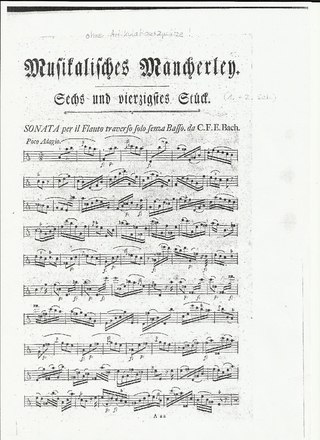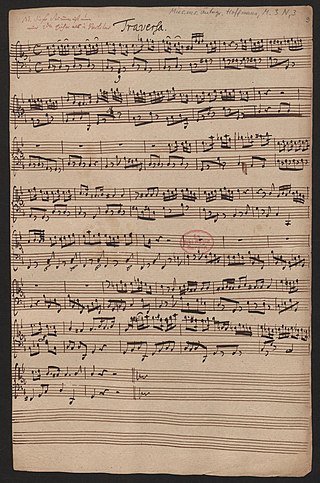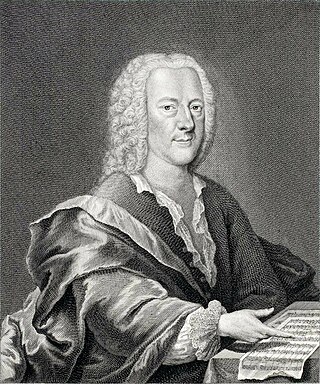
Carl Philipp Emanuel Bach, also formerly spelled Karl Philipp Emmanuel Bach, and commonly abbreviated C. P. E. Bach, was a German Classical period composer and musician, the fifth child and second surviving son of Johann Sebastian Bach and Maria Barbara Bach.

In 1724 Johann Sebastian Bach composed the church cantata Meine Seel erhebt den Herren, BWV 10, as part of his second cantata cycle. Taken from Martin Luther's German translation of the Magnificat canticle, the title translates as "My soul magnifies the Lord". Also known as Bach's German Magnificat, the work follows his chorale cantata format.

Jesu, meine Freude, BWV 227, is a motet by Johann Sebastian Bach. The longest and most musically complex of Bach's motets, it is set in eleven movements for up to five voices. It is named after the Lutheran hymn "Jesu, meine Freude" with words by Johann Franck, first published in 1653. The motet contains the six stanzas of the hymn in its odd-numbered movements. The hymn tune by Johann Crüger appears in all of these movements in different styles of chorale settings. The text of the motet's even-numbered movements is taken from the eighth chapter of the Epistle to the Romans, a passage that influenced key Lutheran teachings. The hymn, written in the first person with a focus on an emotional bond with Jesus, forms a contrasting expansion of the doctrinal biblical text. Bach set both texts alternating with and complementing each other, in a structure of symmetries on different layers.

Johann Sebastian Bach's Magnificat, BWV 243, is a musical setting of the biblical canticle Magnificat. It is scored for five vocal parts, and a Baroque orchestra including trumpets and timpani. It is the first major liturgical composition on a Latin text by Bach.
Most of Johann Sebastian Bach's extant church music in Latin—settings of the Mass ordinary and of the Magnificat canticle—dates from his Leipzig period (1723–50). Bach started to assimilate and expand compositions on a Latin text by other composers before his tenure as Thomaskantor in Leipzig, and he continued to do so after he had taken up that post. The text of some of these examples by other composers was a mixture of German and Latin: also Bach contributed a few works employing both languages in the same composition, for example his early Kyrie "Christe, du Lamm Gottes".

Bach's Missa of 1733, BWV 232 I, is a Kyrie–Gloria Mass in B minor, composed in 1733 by Johann Sebastian Bach. It is an extended missa brevis consisting of a Kyrie in three movements and a Gloria in nine movements. Bach started to compose it, partly based on earlier work, after the death of his sovereign Augustus the Strong, dedicating it to the latter's son and successor, Frederick August II, in a letter dated 27 July 1733. At the time, Bach was in his tenth year as Lutheran church musician in Leipzig, while the Catholic court of the sovereign Elector of Saxony was located in Dresden. Bach sent performance parts of his Missa to Dresden while he kept the autograph score in Leipzig. Upon arrival in Dresden, the Mass was not added to the repertoire of the Catholic court chapel, but instead the parts, and Bach's dedication letter, were archived in the sovereign's library.

Heinrich Schütz composed four extant settings of the Magnificat or Song of Mary, one of the three New Testament canticles. He set one in Latin and three in German. In the Schütz-Werke-Verzeichnis (SWV), the compositions have the numbers 344, 426, 468 and 494. The settings on the German text are all part of larger groups of works. They are settings of Martin Luther's German Magnificat, Meine Seele erhebt den Herren. Schütz wrote the compositions for different forces and occasions.

The Magnificat by John Rutter is a musical setting of the biblical canticle Magnificat, completed in 1990. The extended composition in seven movements "for soprano or mezzo-soprano solo, mixed choir, and orchestra " is based on the Latin text, interspersed with "Of a Rose, a lovely Rose", an anonymous English poem on Marian themes, the beginning of the Sanctus and a prayer to Mary. The music includes elements of Latin American music.

The Magnificat in E-flat major, BWV 243a, also BWV 243.1, by Johann Sebastian Bach is a musical setting of the Latin text of the Magnificat, Mary's canticle from the Gospel of Luke. It was composed in 1723 and is in twelve movements, scored for five vocal parts and a Baroque orchestra of trumpets, timpani, oboes, strings and basso continuo including bassoon. Bach revised the work some ten years later, transposing it from E-flat major to D major, and creating the version mostly performed today, BWV 243.
Performances of Johann Sebastian Bach's Magnificat come in three formats:
- D major version, BWV 243 with the twelve movements of that version;
- D major version, with the Christmas interpolations from the earlier version BWV 243a transposed and inserted after movements 2, 5, 7 and 9.
- E flat major version, BWV 243a. The difference with the previous format is not only the key signature, there are also differences in orchestration, e.g. in the earlier version flutes are not part of the tutti, so do not play in the choral movements 1, 7 and 12, and a trumpet solo in movement 10 instead of the later unison oboes. Other differences are minor, but there is for instance a slightly harsher harmony near the end of movement 4 in the earlier version.

The Sonata for Solo Flute in A minor, Wq.132, H 562, is a sonata for flute, without Basso Continuo or accompanying instruments, composed by Carl Philipp Emanuel Bach. The sonata is considered, along with Telemann's Fantasias for Solo Flute and J. S. Bach's A minor partita, one of the most significant works for unaccompanied flute before the 20th century. It is the sole flute work by Bach that was printed and published during his lifetime. No manuscript of it has been discovered.
Uwe Wolf is a German musicologist. He worked for the Johann Sebastian Bach Institute in Göttingen and Bach-Archiv Leipzig, where he developed the Bach Digital website. Since 2011, he has been chief editor of Carus-Verlag, editing the 2013 edition of Monteverdi's Vespro della Beata Vergine, among others.

Pietro Torri's Magnificat in C major, a setting of the biblical Canticle of Mary, the Magnificat, for double choir and orchestra likely dates from the 1690s. The work is scored for two SATB choirs, two trumpets, bassoon, strings and basso continuo. Its music opens with an instrumental introduction (sinfonia). Most of the composition's movements are either choral movements, in which all singers and instruments participate, or duets for two singers and a more limited instrumental accompaniment.

The Magnificat in A minor, BWV Anh. 21, TWV 1:1748, is Melchior Hoffmann's musical setting of a German version of the Song of Mary from the Gospel of Luke. The composition originated around 1707, when the composer was director musices and organist of the Neue Kirche in Leipzig. Composed in A minor, the Magnificat is scored for soprano and small orchestra. The work was first published in the 1950s, and it was recorded by Magda László, by Joshua Rifkin, by Wolfgang Helbich, and by Deborah York, among others.

Georg Philipp Telemann composed the motet Ein feste Burg ist unser Gott, TWV 8:7, setting Luther's hymn in German, "Ein feste Burg ist unser Gott", for a four-part choir and continuo. The motet was first published around 1780. A modern edition was published by Carus-Verlag.












